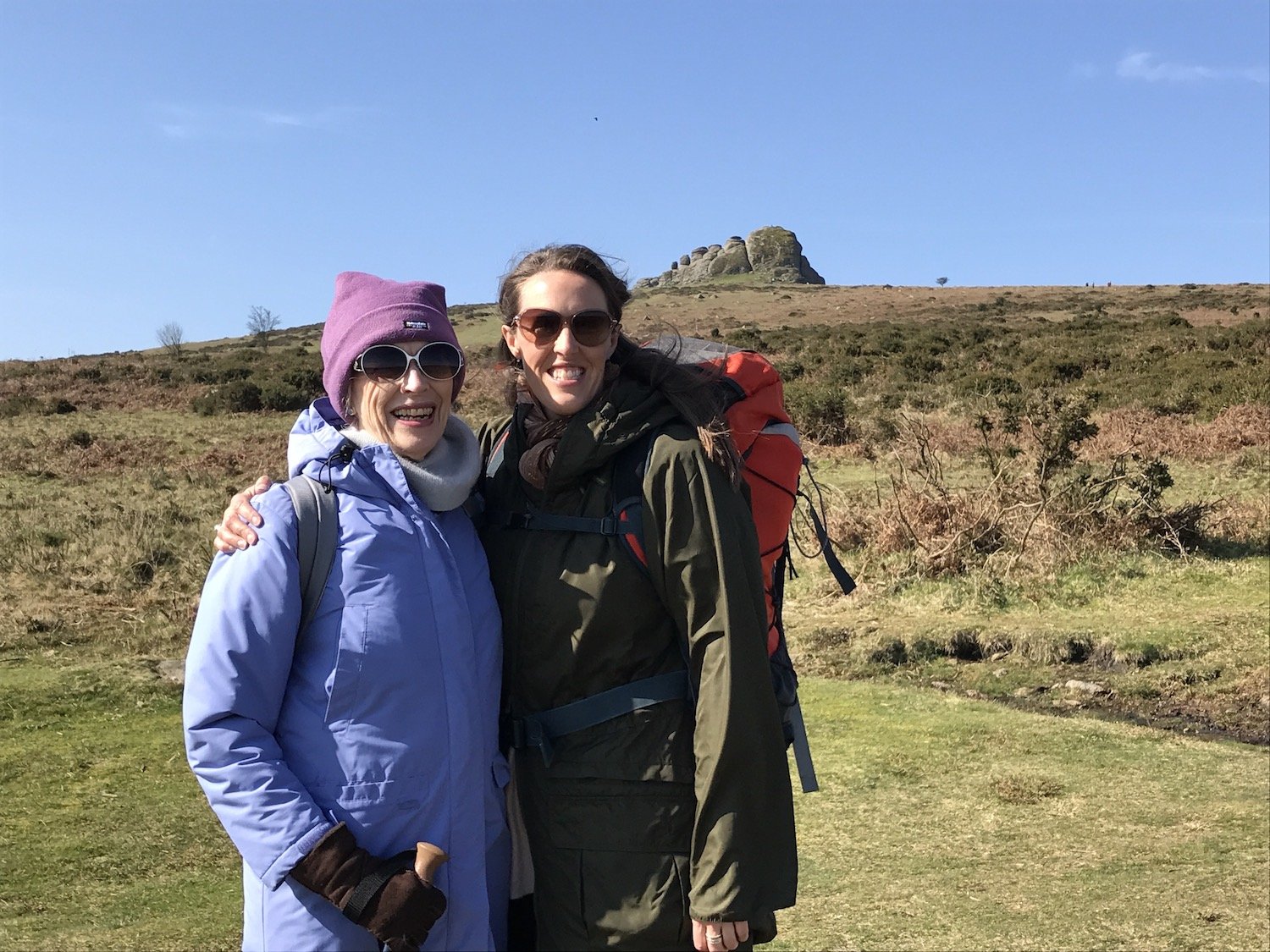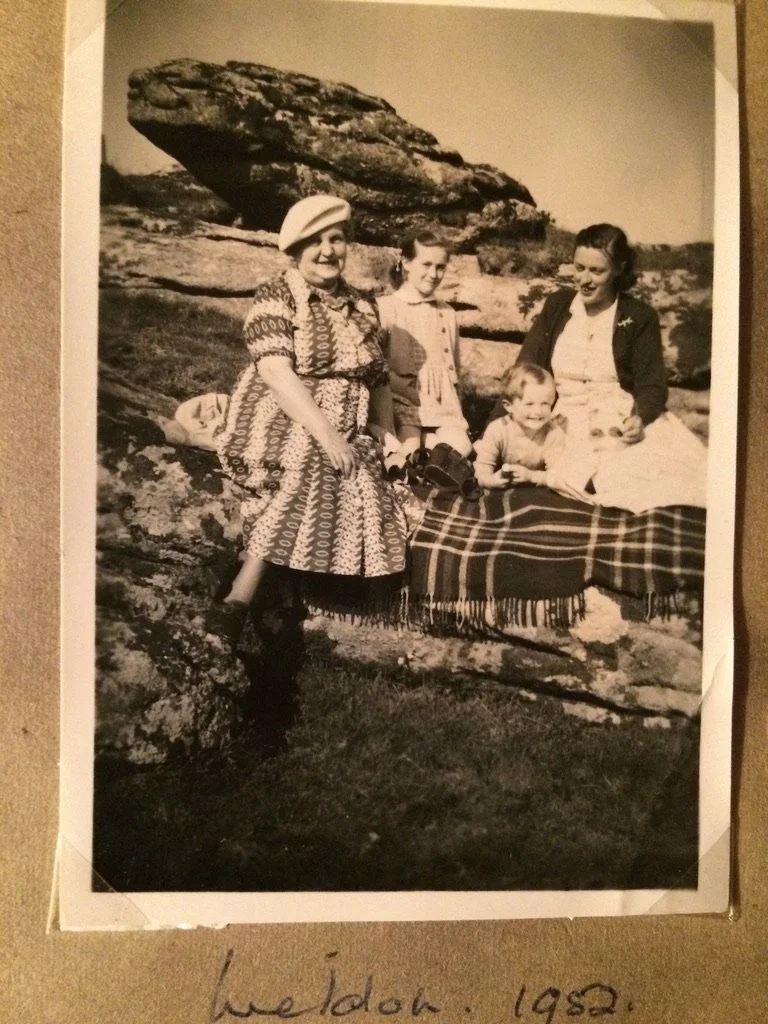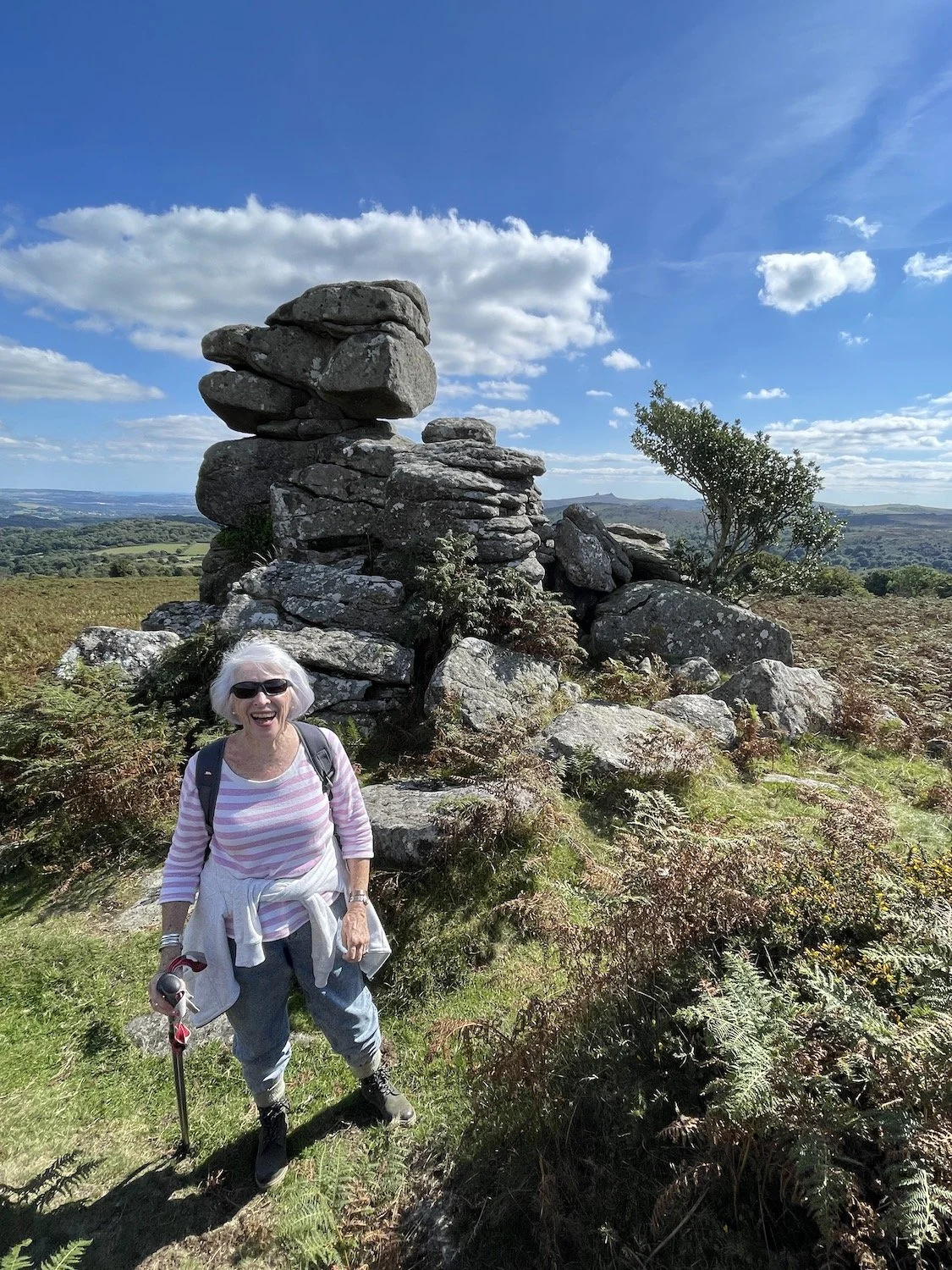Dartmoor People: A journey back to the land's embrace
Emma Cunis, visionary founder of Dartmoor’s Daughter, guides people to Dartmoor’s ancient wisdom and healing power. After a global career and recovery from ME/Chronic Fatigue Syndrome, she returned to her Devon roots to help others reconnect with nature, themselves, and community. Lucy Johnson from Dartmoor Magazine meets her and her mother, Sally.
Article by Lucy Johnson, originally published in the Dartmoor Magazine, 2025
For many, a childhood spent roaming freely through fields, climbing tors, and swimming in rivers is a nostalgic dream. For Emma Cunis, it was simply life.
"Free range for me meant cycling, riding ponies, walking, building camps in the woods, swimming in the river with my brother, Guy, and often without any parents with us because we lived such a rural life in Mid Devon," Emma vividly remembers. Her mother, Sally, played a key role. "Mum grew up on Dartmoor in the latter part of her childhood, and really instilled a love of the moor in us. I have memories of walking around fields and lanes at home with our dog, hearing the wind in the trees and Mum saying, 'Can you hear what the wind is saying?' or looking down rabbit holes and Mum asking “Is anybody home?" like in the Winnie the Pooh stories.
Weekends and holidays meant trips to Dartmoor to visit their grandmother. "Mum would take us to her favourite places," Emma recalls. "We never had any maps and we just walked to the places she knew so well, whatever the weather. We’d have soggy picnics in the sun or rain, it didn’t matter as long as we were outside." The distant ring of a handbell, signalling supper, was often the only thing that could draw her and her siblings home on long summer evenings.
Sally and her family on Meldon Hill, above Chagford.
This deep connection to the land runs through Emma's family, especially through her maternal family who had visited and lived around Chagford for several generations. Her grandfather was the celebrated Dartmoor guide and author Eric Hemery. Sally explains “My father moved us down here in the 50s, and we always seemed to be moving house but always around Chagford and Gidleigh, and latterly Widecombe." Emma adds that her grandfather, a WWII veteran, found healing on the moor. "He had ended up with a dodgy leg after the war, and he started walking and riding as a way of healing it." This soon became his profession. "In the 1950s he set himself up as 'The Dartmoor Guide'," says Emma, "because whilst there were knowledgeable locals guiding in their respective areas, there was no one else at the time guiding across the whole of Dartmoor." Sally remembers accompanying him on these early guided walks and riding holidays, a powerful lineage of guiding that Emma proudly continues.
As a teenager, Emma longed for the buzz of city life. "I wanted to get away to the bright lights and big cities," she admits. Her corporate career thrived, taking her to Hong Kong, New York and London where she ran high-pressure teams. "I was burning the candle at every possible end."
After losing friends in the Bali bomb, Emma began to miss home and walked on the moors during visits back. The relentless corporate pace eventually took its toll and she became ill with ME/CFS. "This led to a questioning of my high stress corporate life, the values of that environment, and the damage to the planet of so much consumerism," Emma reflects. "I felt so drawn to coming back to Dartmoor. I eventually decided I needed to quit my job. I knew I had to come back closer to nature and I needed a gentler, calmer life." This decision was spurred by ME/Chronic Fatigue Syndrome.
Upon her return, Emma spent a year focusing on rest and holistic healing. "I’d retrained as a macrobiotic counsellor," she explains. This process "peeled back a lot of layers of corporate life" and was crucial for her ongoing journey towards recovery, allowing her to rediscover the simple joy of being in nature. "Part of that healing journey was walking again on the moor, spending hours just sitting by a river, or lying in a stone circle and rediscovering seasonal patterns."
During this time of healing, the idea for Dartmoor’s Daughter emerged. "For months, every time I came up to the moors, I would hear this phrase 'Dartmoor’s Granddaughter'," Emma says. She spent time with her grandmother, listening to stories of life on the moors and her grandparents’ guiding business. "I felt like I was walking in the footsteps of my ancestors." Her connection to her heritage and a growing sense of purpose led her to specific sites. "I would go to a stone circle and something would say, 'You need to bring people here.'"
“I want people to come here and feel a deeper sense of connection in their bodies, or with each other and with the landscape, and then care about it more.”
Despite initial hesitation, Emma found strong motivation in the narratives surrounding Dartmoor. The first walk took place in 2014. "I invited family and friends. People really enjoyed them and I had good feedback." This positive response confirmed her path. She gained her Hill and Moorland Leader qualification, and by 2015, Dartmoor's Daughter officially launched, initially on a donation basis.
Emma’s main goal was clear: "I want people to come here and feel a deeper sense of connection in their bodies, or with each other and with the landscape, and then care about it more." She creates walks, talks and nature-connection experiences that have diverse topics and themes, always making sure they are fun. "Underneath, I feel quite forceful about encouraging people to learn and care about Dartmoor – the landscape, wildlife, and cultural heritage, but on the surface, it’s about coming along and enjoying the day," she admits. Emma continually expands her own knowledge, talking to, and where possible getting involved with learning from, landowners, farmers, dry stonewallers, hedge layers, artists, ecologists, and all the people who live and work on the moors. She hopes participants find a deeper connection within themselves and with each other, leading to greater care for nature and the landscape.
Dartmoor's Daughter quickly set itself apart from typical guided walks. Emma’s offerings are immersive experiences designed to cultivate a deep connection to your inner self and Dartmoor’s wild nature. This means integrating elements beyond simple navigation: "From exploring ancient tracks to learning natural navigation, and from delving into geology and folklore to experiencing wild swimming." As part of her own training, she also studied bushcraft, foraging, shamanism, mindfulness, and more.
Slowing down forms a key part of Emma's approach. "Most of my adult walks I start with a brief meditation," Emma explains, "encouraging people to feel around them and connect with their bodies. It slows down our minds and helps everyone to feel more and be in the present moment where they can appreciate the tiny details as well as vast views." Her mother, Sally, echoes this sentiment: "Slowing people down and getting them to feel the connection with the earth is so important." This deliberate pacing enables a more personal engagement with the environment.
Participants often describe a transformative experience. The meditations, in particular, frequently lead to powerful responses. Emma’s favourite walk, a stone circle journey, illustrates this: "We walk through different landscapes and some of the walk is done in silence and I love that. This connection eliminates the need and pressure for social chit-chat."
“Dartmoor is a powerful place and it is a healing place. I’ve always thought there is magic on Dartmoor.”
The story of Dartmoor's Daughter is profoundly shaped by Sally, whose own life is deeply intertwined with the moor. "Dartmoor is a powerful place and it is a healing place. I’ve always thought there is magic on Dartmoor," she says.
Emma’s vision for Dartmoor's Daughter is clear: "I feel like I am being called to stand up on behalf of Dartmoor more strongly," she states, hinting at future advocacy. When she leads walks and coach tours, where visitors are often ‘blown away by the beauty of Dartmoor,’ she discusses crucial local issues, such as the challenges faced by farmers, climate change and wildlife decline, and the ongoing right to roam debate which must come with greater education about responsible access. She passionately shares her appreciation for Dartmoor, hoping to inspire others to find joy and a renewed sense of belonging and care.
Dartmoor's Daughter is a heartfelt invitation to rediscover a fundamental bond with the earth. Through Emma's carefully crafted experiences, guided by her transformation and Sally's lasting legacy, people are led to an innate bond with nature, the wild spirit of Dartmoor, and a renewed sense of purpose. Through their shared love and inherited wisdom, the Cunis women ensure Dartmoor's magic endures, establishing a profound tie to the land.
Favorite Dartmoor Spots
Emma and Sally share their favourite places on Dartmoor, highlighting personal connections and the unique charm of the landscape.
Favourite walk
Sally at Figgie Daniel on Easdon, a place deeply connected to her childhood.
Emma loves the walk encompassing Kestor, Shovel Down, and up the Teign to Watern Tor. "The emotional connection when I was young" draws her to this landscape, as well. "I love the stone rows and circles because to me they feel sacred and below here you have the woodland with Mariners Way including the wonderfully named ‘Featherbed Lane’."
For Sally, the favourite walk is around Scorhill and the North Teign River where she spent so much time as a child riding ponies ‘Chips’ or ‘Oliver’ borrowed from Moortown Farm when they lived in the cottage there for a few years. She finds "something incredible about the amphitheatre with the hills all around" in this area.
Favourite places to eat
Both Emma and Sally enjoy picnics on the moor. Sally also recommends The Globe Inn and the Ring O’ Bells in Chagford. She has a particular fondness for the Warren House Inn, recalling how her father used to lead groups there as part of their trekking holidays across Dartmoor where they stayed overnight in farmhouses such as Brimpts and Headland Warren. Horses were hired from Diana Coaker and whilst guests enjoyed their lunch and the great views, Sally remembers unsaddling the horses so they could enjoy rolling around on the grass!’. The Two Bridges Hotel is another preferred spot, especially for their homemade cream teas.
Favourite place to visit
For both Sally and Emma, Chagford stands out as their favourite place to visit. They describe it as "such a magic place." "You have the combination of it being a working town where you have farmers, tractors through town, ponies roaming in off the common, and you have the lovely mix of shops and pubs, artists and wonderful people." It's an eclectic group of people.
Dartmoor Myths & Legends
Emma's new book, Dartmoor Myths & Legends: Exploring Origins and Inspirations, is now available on her website.
The book uncovers the real histories and possible origins behind Dartmoor's famous tales of giants, pixies, witches, and mythical creatures. It delves into the inspirations for legends like the Devil at Widecombe Church, 'Hairy Hands', and The Hound of the Baskervilles.
Journey through these stories to discover how Dartmoor's extraordinary landscape has shaped imagination and commanded respect for around 12,000 years. The book explores how these ancient tales governed past rural communities and their relevance today, offering a sense of belonging and reconnection, while also posing questions about new stories waiting to be shared.




